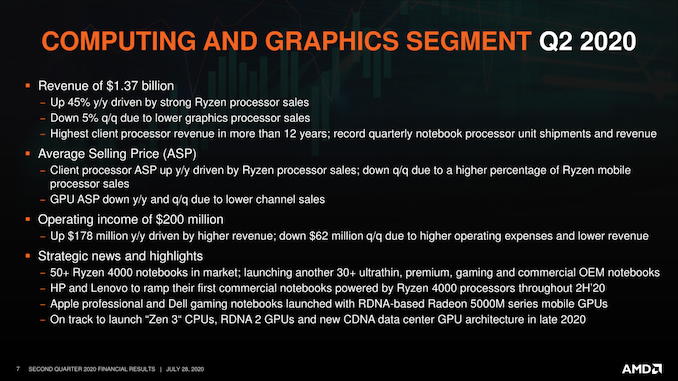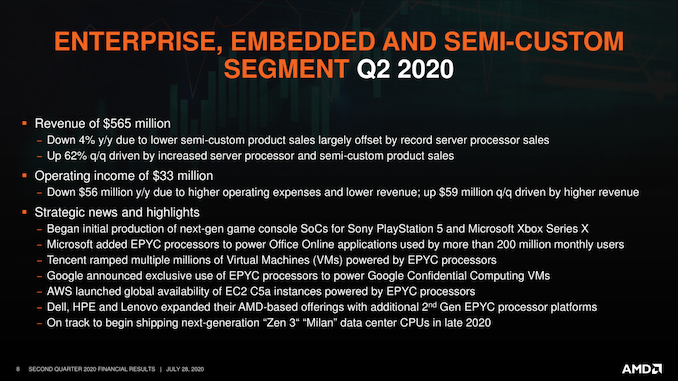AMD Reiterates 2020 Roadmap: Zen 3 Client & Server, RDNA 2, CDNA Late This Year
by Ryan Smith on July 28, 2020 5:50 PM EST
As part of AMD’s quarterly earnings presentation, the company has briefly reiterated its product plans for the second-half of the year. The company was previously slated to launch new CPUs and GPUs for the client and server markets late this year, and on today’s call the company has confirmed that those plans are on track.
On the client side of matters, both AMD’s new CPUs and GPUs are currently set to launch late in 2020. The first GPUs based on the company’s RDNA 2 architecture – which is also underpinning the new Playstation 5 and Xbox Series X consoles – will be released later this year. And AMD is confirming that RDNA2 will eventually be a “full refresh” of the company’s GPU product stacks. Meanwhile the eagerly anticipated Zen 3 architecture is set to make its desktop debut late this year as well. As always, with these sorts of events it’s prudent to note that a commitment to launch a product by a certain date doesn't guarantee that AMD will be able to have it on retail shelves by that date – though it sounds like AMD is certainly going to give it their all to avoid disappointing their user base.
Meanwhile on the server side of matters, the picture is much the same. AMD reports that they are on track to begin shipping the Zen 3-based “Milan” EPYC processors late in 2020. As well, AMD’s first CDNA architecture GPU for the data center market is set to launch late this year as well.
Source: AMD












83 Comments
View All Comments
inighthawki - Tuesday, July 28, 2020 - link
Right now, I suspect most people using it are just experimenting with the technology and preparing it to be integrated into their engines, and the current implementations are more previews than anything. However as the hardware matures I expect to see it become more and more common.brucethemoose - Tuesday, July 28, 2020 - link
Outside of gaming, its already used to accelerate non-realtime rendering (in Blender's Cycles renderer, for instance).Hardware accelerated raytracing is extremely useful, but like NVENC/VCE and other fixed-function features, it takes time to propagate. Graphics programming is hard.
TBH I think the tensor cores are a bigger deal.
Yorgos - Wednesday, July 29, 2020 - link
no.techilliterate dot com sites are pushing it due to novidia's guideline.
this marketed ray tracing has nothing to do with pure ray tracing implementations.
you need around the petaflop mark in order to render a complex scene with pure ray tracing.
we didn't get there with single gpus nor we found a ground breaking algorithm to avoid all those calculations.
rtx and the current ray tracing for the kasses implementations are marketing scums. they will die off eventually like vr, ar, 3d gaming glasses, etc.
nandnandnand - Wednesday, July 29, 2020 - link
Pure ray tracing is not needed.Both Big Navi and Ampere should have acceptable real-time denoised ray tracing performance.
MrVibrato - Wednesday, July 29, 2020 - link
VR, AR, 3D gaming all suffered from the following things that makes the difficult and fail in the market: Dedicated devices the user had to buy. Designing the user experience utilizing those technologies was a problem. Avoiding undesirable physiological reactions of the users (nausea, etc...) was a problem.Granted, RT on GPUs that are sold today is not powerful yet to be really useful for software producers nor users. Whether RT on GPUs will prosper or die will just depends on how powerful the feature can/will become.
RT on GPUs does not require you to buy separate hardware to use it (it is just a feature of your otherwise bog-standard GPU).
It does not require software developers/designers to design based on a different UX - software can still be interacted in the same way regardless of RT is used or not.
And, RT on GPUs won't make the users puke. With the exception of enthusiast tech website commenter primadonnas, of course ;-P
Lord of the Bored - Wednesday, July 29, 2020 - link
VR's still growing, actually. Not explosively like some people'd assumed, but fast enough that manufacturing capacity continues to be the limiting factor. Both Valve and Facebook are selling headsets faster than they can make them.nandnandnand - Wednesday, July 29, 2020 - link
Turing is a ray tracing beta test. It will actually get used with Ampere, Big Navi, and consoles.Spunjji - Wednesday, July 29, 2020 - link
Early Access: GPU Hardware EditionThey even mimicked the way the original buyers won't get the final product without paying extra 😆
medi05 - Wednesday, July 29, 2020 - link
"as Navi without ray tracing sells poorly"Yeah, mere 30-40% of the GPU cards sold now are AMD, which means it is "selling poorly", since gamers are so concerned about that wonderful feature, that 1% of games support, that is capable of bringing 2080Ti framerate to a point you need to run it at 1080p.
brunis.dk - Wednesday, July 29, 2020 - link
Riiight, everyone wants to play Raytraced Minecraft.. it's like the market for triple GPU's for Sc2 and WoW .. 0,001%